The Manchester Engineering Campus Development (MECD) is a huge, ultra-modern structure that will soon house the University’s School of Engineering. Its layout – contemporary, innovative, ambitious – is painstakingly designed to meet the every need of today’s student.
Within the development, however, sits a reminder of the University’s – and Manchester’s – proud heritage. Oddfellows Hall is a beautiful, intricate Grade II Listed building, impressive both outside and in.
Here we discover its incredible history…
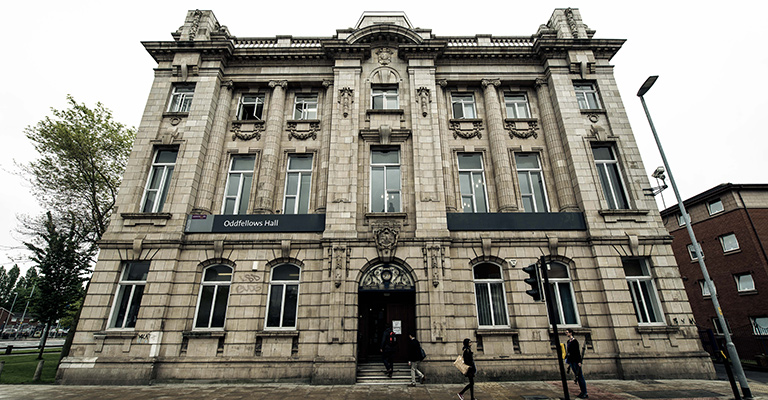
The Oddfellows Society
The hall’s Edwardian Baroque style is striking against MECD’s 21st century design. Constructed in 1857 and rebuilt in 1916, the hall belonged to the Oddfellows Society, a non-political society that strives to promote friendliness, benevolence, charity and philanthropy – and continues to operate to this day.
It dates back to 1810; though some suggest the fraternity can be traced back as far as 587 BC, with the forming of a brotherhood linked to the exile of the Israelites in Babylon.
‘Odd Fellows’ was one of a number of fraternal societies established in England following the decline of trade guilds in the 18th century. These societies supported workers who’d fallen on hard times, and the Odd Fellows represented craftsmen from various smaller trades that, unlike much larger trades organised into guilds, were deemed ‘miscellaneous’ or ‘odd’.
Secrecy and suspicion
Meetings were held in branches, or ‘lodges’. Know of a pub today called The Oddfellows Arms? Well there’s a good chance it was once an Odd Fellows lodge. In fact, landlords of the time were willing to name their pubs after the society in return for the increased trade that came with hosting a meet-up.
Odd Fellows and other societies, however, soon aroused suspicion among government authorities (not least for their use of passwords, oaths and other ‘secretive’ methods). Against the backdrop of the French Revolution, societies of this type were outlawed – yet the Odd Fellows would continue as a ‘secret society’.
The society as we know it today was formed in Salford in 1810. At a meeting in The Ropemakers Arms on Chapel Street, dissatisfied members of the old Manchester District of The Grand United Order formed a breakaway society: the Independent Order of Oddfellows Manchester Unity. This would become the Oddfellows Society, and would acquire the site of 93-97 Grosvenor Street, Manchester.
‘Oddies’, as members are known, had found a new home.
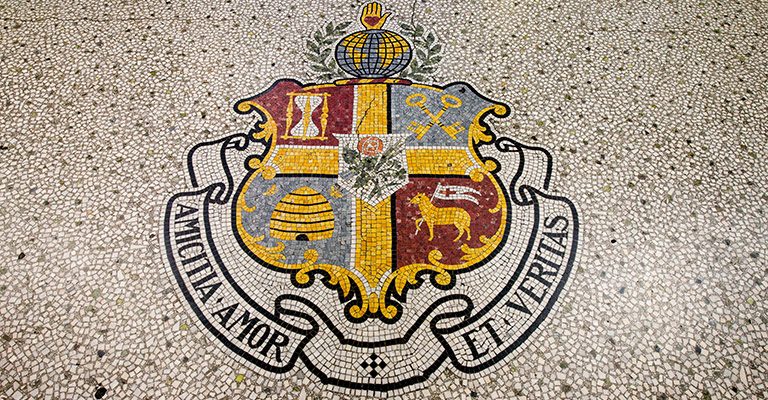
Decorative, distinctive
The Edwardian Baroque style of Oddfellows Hall certainly stands out. It’s not the only architectural gem to be found on Grosvenor Street, however. Look down the road and you’ll notice the Deaf Institute (formerly the Deaf and Dumb Institute) and the Footage (formerly the Grosvenor Picture Palace). Like Oddfellows Hall, both have striking facades. Again like Oddfellows Hall they’re both frequented by students – only much more for partying than learning these days!
Elaborate, highly decorative features are to be found throughout Oddfellows Hall. They include an Art Nouveau tile scheme and an original terrazzo floor, complete with marble mosaic inlay depicting the Oddfellows Society crest. An interesting detail on the crest is the ‘three links’ symbol at the top, which represents the society’s motto: friendship, love and truth. When the society was first formed, symbols such as these would have been very useful for communicating to its workers – many of whom could not read.
The building came into the hands of the University in the 1960s, when it was in the process of buying properties in the area. The society would relocate to new premises on Fountain Street in the city centre, and as recently as 2014 it moved headquarters once more, this time restoring a grand Victorian building (again, Grade II Listed) on Deansgate, not far from the University’s John Rylands Library.
Initially the University intended to demolish Oddfellows Hall to make way for a new Metallurgy Department, planned for 1970. In the meantime it decided to make the building available for temporary uses.
Step forward the Science and Industry Museum.
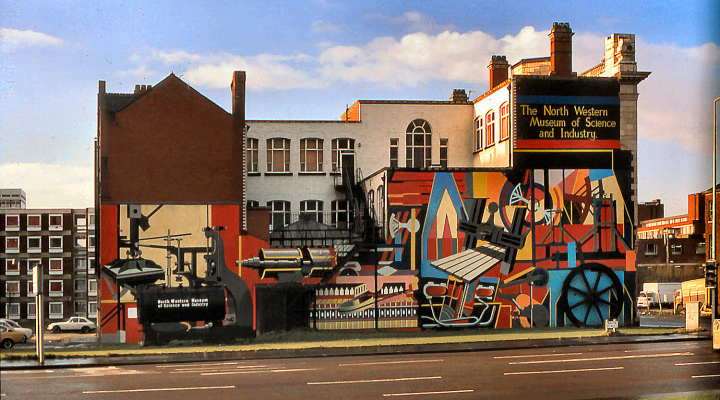
A place of science and technology
Only it wasn’t called the Science and Industry Museum back then. Nor was it the only resident of the building. The Manchester Museum of Science and Technology was in search of temporary premises while its newly-bought site at Liverpool Road Station – where the museum stands proud today – was being redeveloped. It moved into the Grosvenor Street site along with the Methodist Chaplaincy, which was also in need of a temporary home.
In 1972 the Methodist Chaplaincy moved on, and the museum took over the whole building. In the same year it renamed itself the North Western Museum of Science and Industry, and not long after the name would be emblazoned across the side of the building – along with a huge, vibrant mural depicting industry-in-action.
The building would house the museum until 1983. An economic downturn meant the redevelopment of the Liverpool Road Station site (formerly the Manchester end of the Liverpool and Manchester Railway, the world’s first inter-city railway) was delayed. On 15 September 1983, however – the 153rd anniversary of the Liverpool and Manchester Railway – the museum would open at the place it still resides today, with ‘The Power Hall’ its first major gallery attraction.
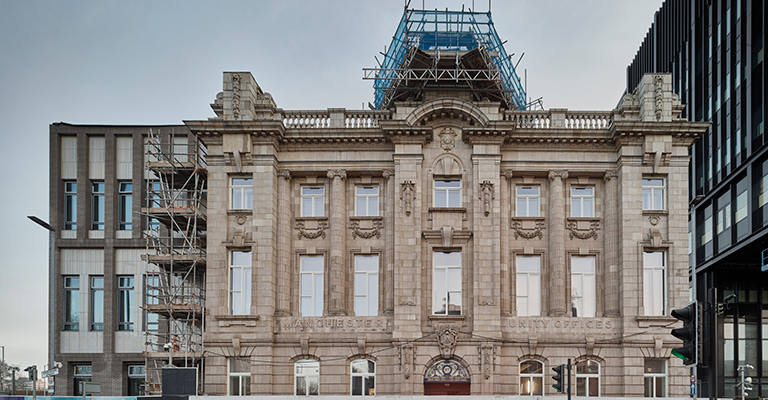
Moving forward with MECD
And so to today. Following a number of years serving as University offices, including housing the University Language Centre and acting as the ‘headquarters’ for the 2004 merger between the Victoria University of Manchester and UMIST – forming what we now know as The University of Manchester – Oddfellows Hall is in the spotlight once again.
This time it will serve as an extension of a brand-new £400 million-plus investment where almost 7,000 students will work and study, with floor space the equivalent of 11 football pitches. It’s an exciting next chapter in the ongoing story of Oddfellows Hall – a charming reminder of history amid the futuristic vision of MECD.
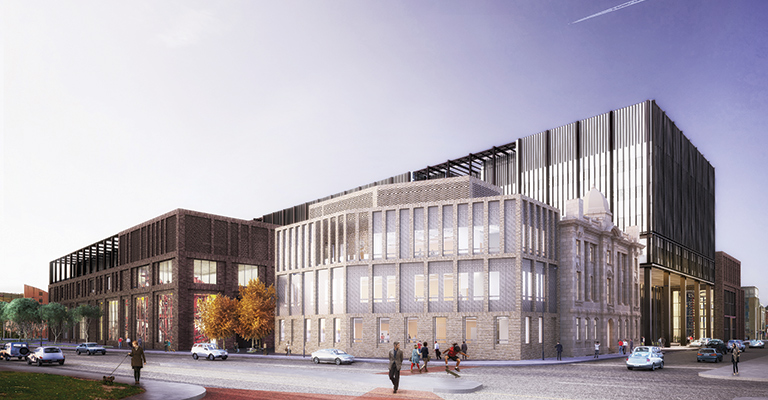
If you enjoyed this post, be sure to subscribe on our homepage to keep up to date with the latest posts from The Hub.
Words: Joe Shervin
Images: The University of Manchester; David Dixon
*Some information within this post is sourced from Stephen Levrant Heritage Architecture Ltd’s heritage report, prepared for The University of Manchester’s Directorate of Facilities and Estates

Comments
One response to “The ‘Oddie’ history of MECD’s Oddfellows Hall”
I have read so many articles about the blogger lovers but this article is really a pleasant paragraph, keep
it up.